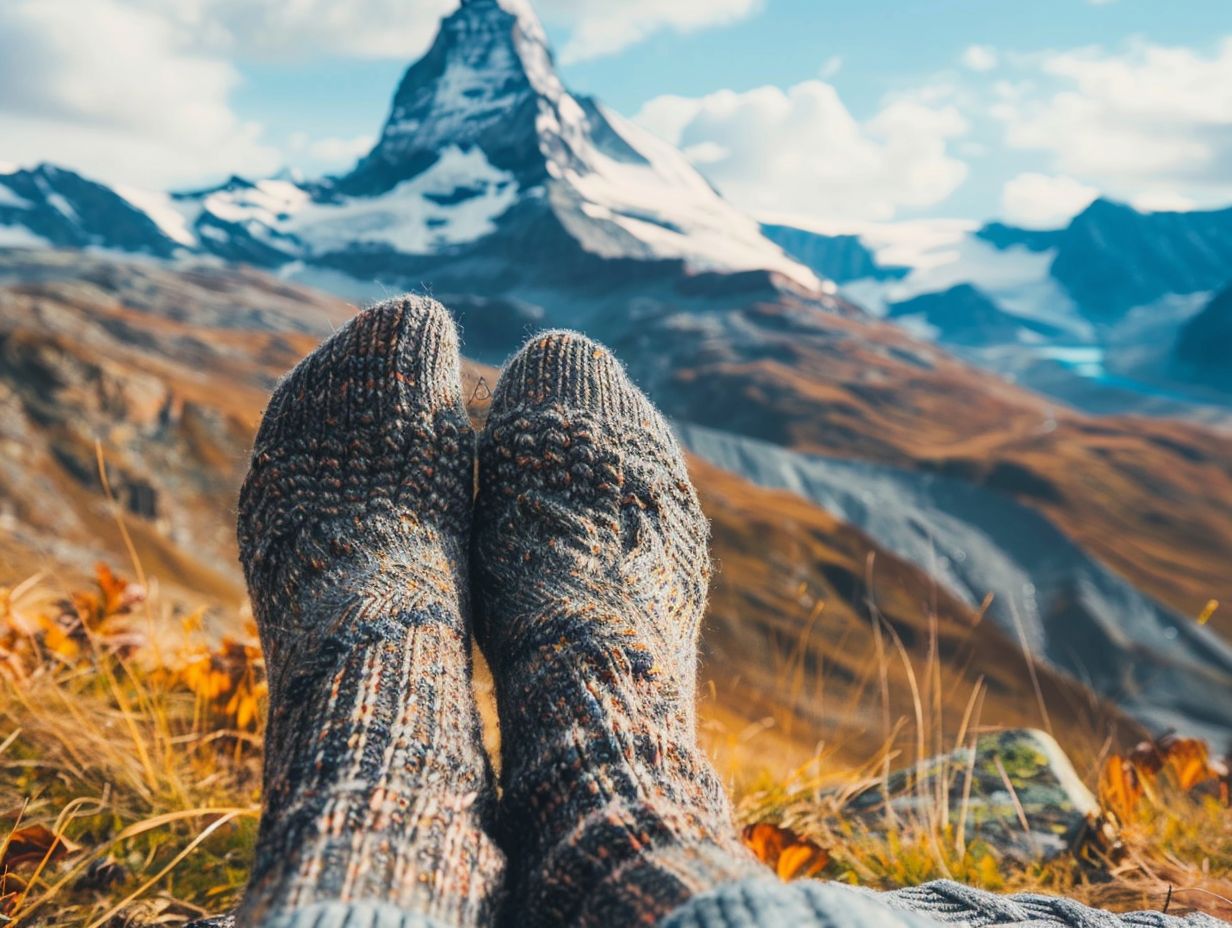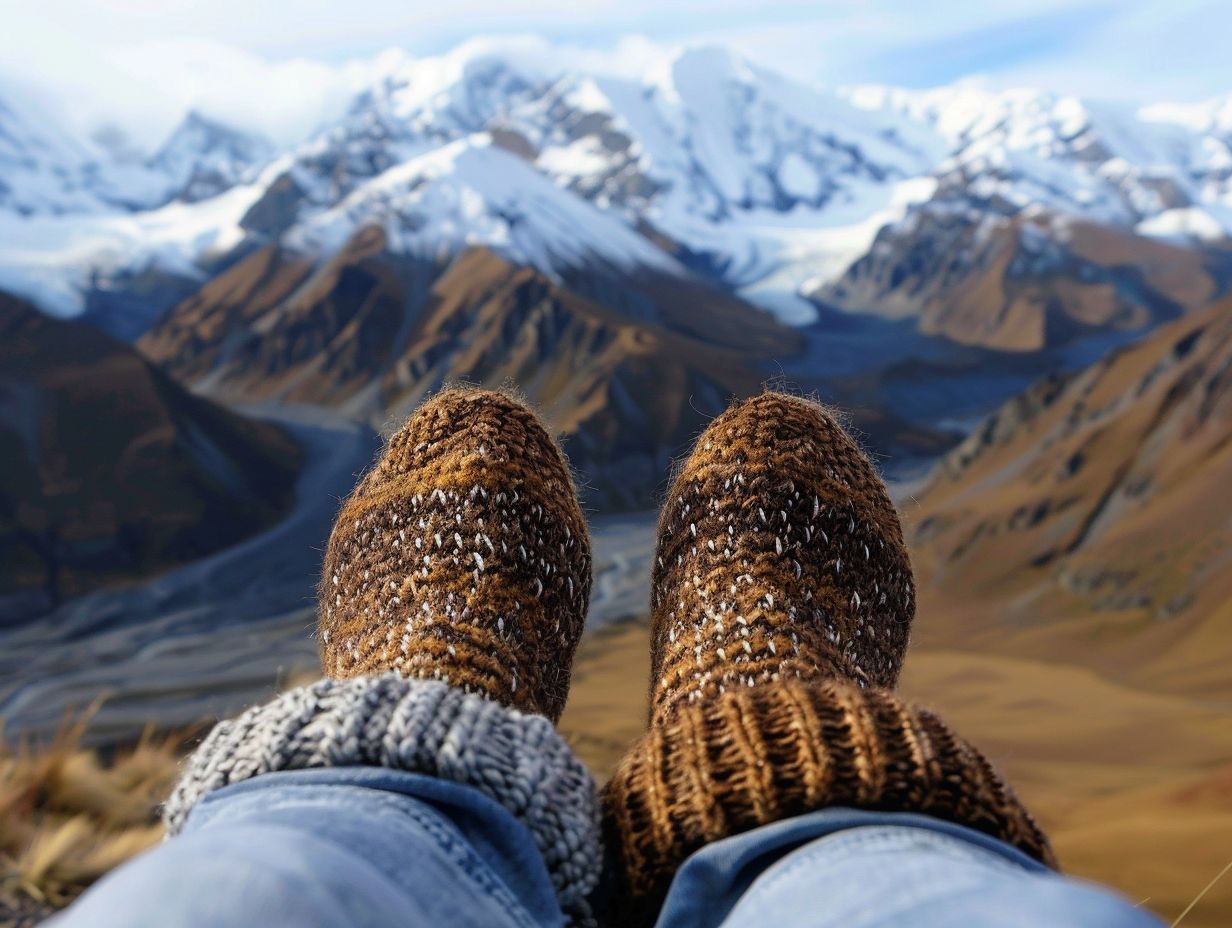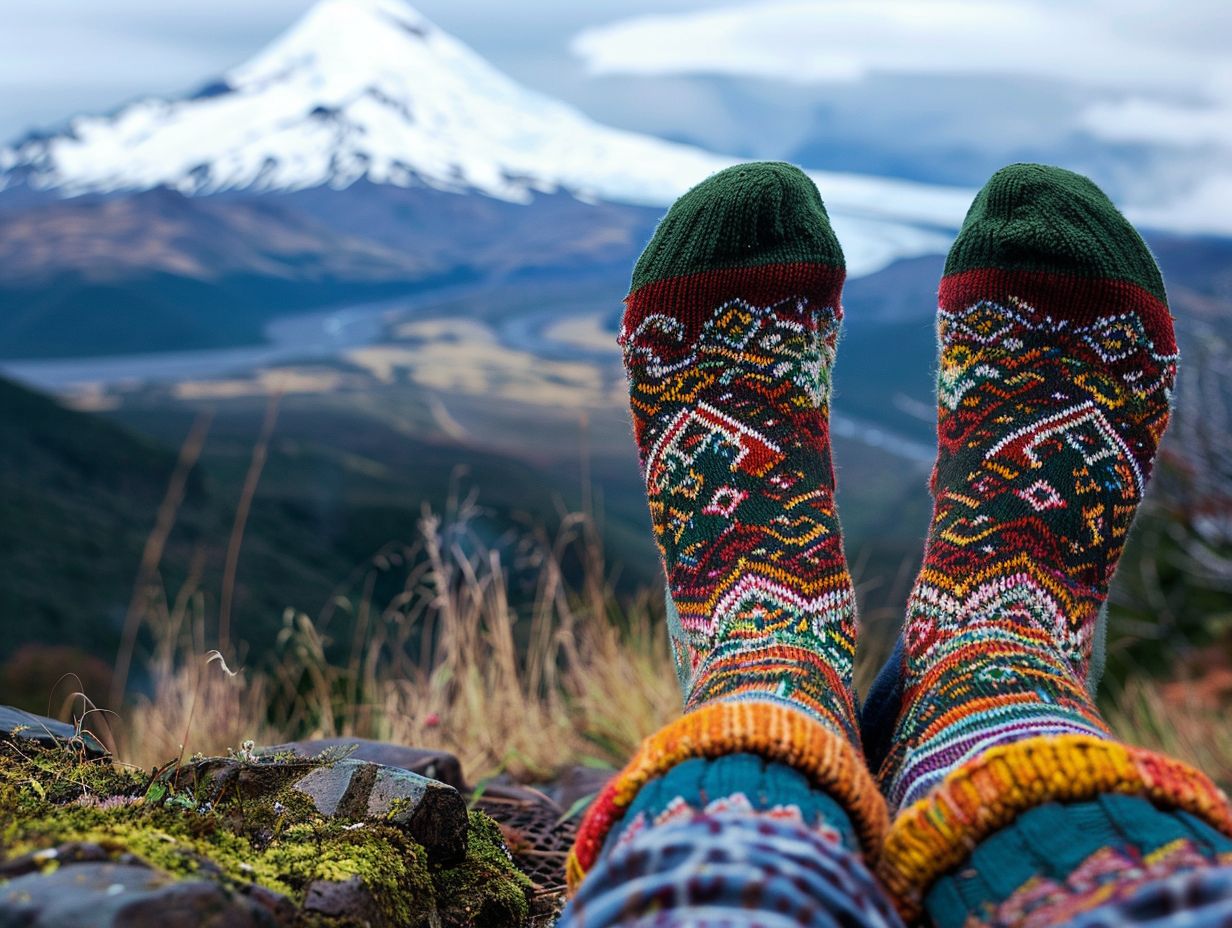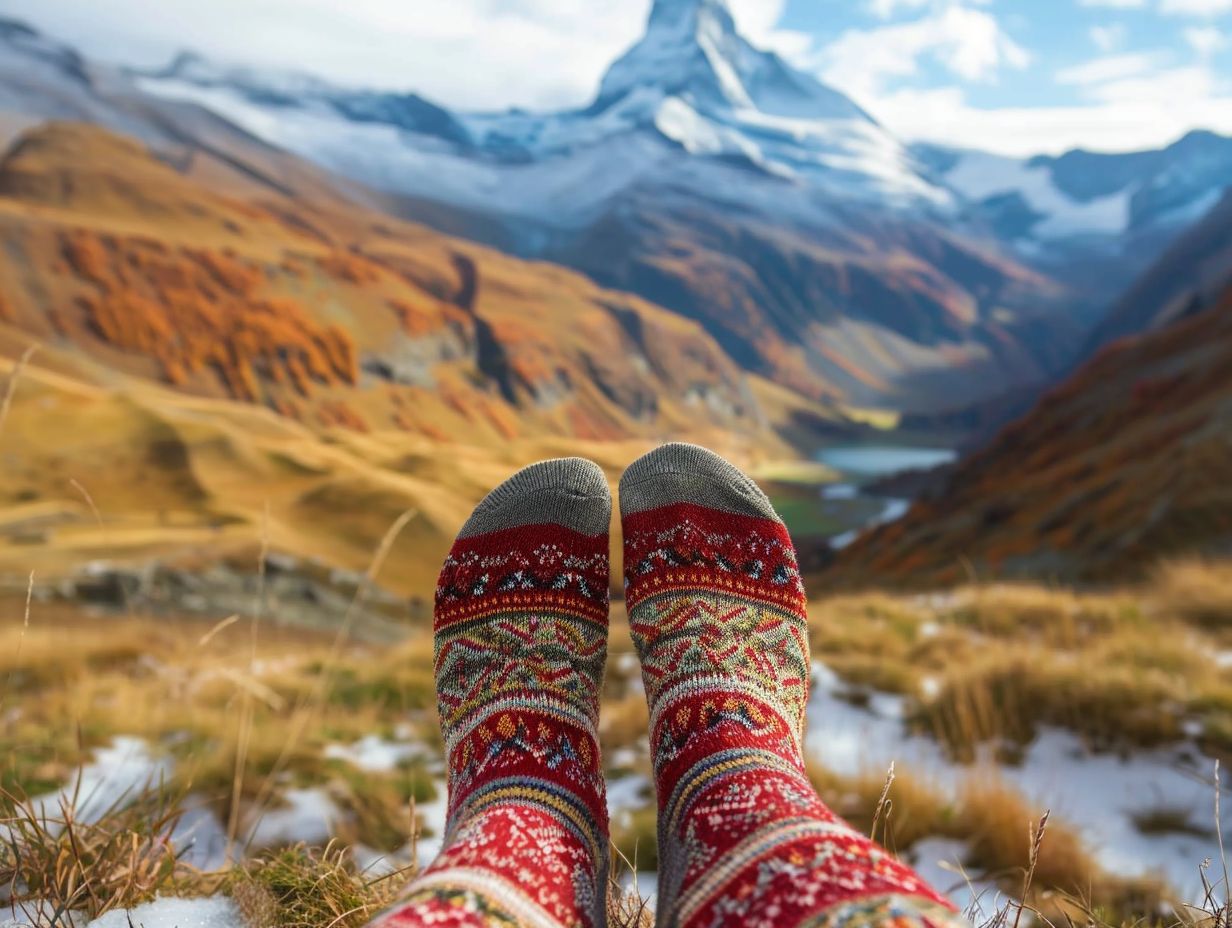
Socks For Kilimanjaro
Are you planning a climb up Mount Kilimanjaro? Don’t overlook the importance of choosing the right socks for this challenging trek.
We explore the different types of socks to consider, such as hiking socks, liner socks, wool socks, and compression socks.
Discover the factors to keep in mind when selecting socks for Kilimanjaro, including material, thickness, fit, and moisture-wicking properties.
Get tips on how to properly wear socks and keep your feet dry and comfortable during the climb.
Key Takeaways:

- Socks are crucial for a successful Kilimanjaro climb due to their ability to prevent blisters, keep feet warm and offer support and comfort.
- The best socks for climbing Kilimanjaro are hiking, liner, wool, and compression socks. They offer different benefits and should be chosen based on personal preference and conditions.
- When choosing socks for Kilimanjaro, consider the material, thickness, fit, and moisture-wicking properties. Keep feet dry and comfortable by changing socks regularly, using foot powder, and keeping boots dry.
Why Are Socks Important During Kilimanjaro Climb?
Socks play a crucial role during a Kilimanjaro climb due to the intense physical demands placed on the feet and the challenging terrain encountered during the ascent. Proper socks can help prevent moisture build-up, reduce friction, and provide cushioning for the feet, enhancing overall comfort and reducing the risk of blisters.
Moisture management is key when it comes to sock choice for a Kilimanjaro climb. Moisture build-up in socks can lead to discomfort, blisters, and even more serious foot issues. Quality hiking socks made from moisture-wicking materials such as merino wool or synthetic blends can efficiently pull sweat away from the skin, keeping your feet dry and reducing the likelihood of blisters.
The friction reduction provided by well-fitted socks can prevent hot spots and the formation of painful blisters during the arduous trek. The cushioning in specialized hiking socks adds an extra layer of protection, absorbing impact and reducing fatigue in each step, making the climb a more bearable experience.
Types of Socks to Consider:
When preparing for a Kilimanjaro climb, it is essential to consider various types of socks, including hiking socks, sock liners, wool socks, synthetic socks, and compression socks, to ensure optimal foot protection and comfort throughout the expedition.
Hiking socks, often constructed with moisture-wicking materials, are designed to keep your feet dry and blister-free during long treks. They provide cushioning and arch support that is crucial for stability on rocky terrains.
Sock liners, on the other hand, add an extra layer of protection and help regulate foot temperature, making them ideal for reducing friction and preventing blisters.
Wool socks are perfect for colder climates as they offer excellent insulation while still effectively wicking away moisture, ensuring your feet stay warm and dry.
-
Hiking Socks:
Hiking socks are specially designed to provide cushioning and support for long treks, making them ideal for the rigors of a Kilimanjaro climb.
One of the key features that sets hiking socks apart for mountainous terrain is their ability to cushion the foot, absorbing shock and reducing fatigue on challenging climbs. This cushioning is crucial when paired with sturdy boots to prevent blisters and provide comfort over miles of rocky trails.
The fit of hiking socks plays a pivotal role in their performance. A snug yet non-restrictive fit ensures the sock stays in place, preventing rubbing and potential hot spots during ascent and descent. The choice of materials such as moisture-wicking fabrics in hiking socks is also pivotal to maintain foot dryness and prevent blisters in demanding conditions.
-
Liner Socks:
Liner socks act as a barrier between the foot and the outer sock, reducing friction and minimizing the risk of blisters, especially in moist conditions.
This additional layer serves as a moisture-wicking agent, drawing sweat away from the skin and allowing it to evaporate more efficiently, thus keeping the feet dry and less prone to blisters. By managing moisture effectively, liner socks assist in maintaining a comfortable environment inside the shoe, crucial during long climbs.
They enhance the fit of the main hiking sock by reducing slippage and bunching, ensuring a snugger and more stable overall feel. This improved fit contributes to better foot alignment and reduces the chances of developing hot spots or discomfort during the journey.
-
Wool Socks:
Wool socks are known for their excellent moisture-wicking properties, cushioning, and natural warmth, making them a popular choice for cold-weather climbs like Kilimanjaro.
One of the key benefits of wool socks is their ability to draw moisture away from the skin, keeping your feet dry and reducing the risk of blisters and discomfort. The natural crimp of wool fibers provides a cushioning effect, adding a layer of comfort and protection for your feet during long treks or hikes.
The insulating properties of wool help regulate foot temperature, keeping you warm in cold conditions without causing overheating. These qualities make wool socks a top choice for outdoor enthusiasts and adventurers seeking both performance and comfort.
-
Compression Socks:

Compression socks offer targeted support and improved circulation, aiding in foot recovery and reducing fatigue during strenuous climbs like Kilimanjaro.
Not only do compression socks provide a snug fit that reduces swelling and minimizes muscle vibration, but they also offer exceptional support to the arches and Achilles tendon, crucial areas for climbers.
Brands like Smartwool Athlete Edition Mountaineer Compression Sock and Sockwell Speedway Firm Compression Socks are specifically designed to cater to the needs of climbers, ensuring a comfortable and secure fit throughout the ascent. By enhancing blood flow and oxygen delivery to the muscles, these socks can significantly improve performance and endurance on challenging terrains.
Factors to Consider When Choosing Socks for Kilimanjaro:
When selecting socks for a Kilimanjaro climb, it is essential to consider factors such as material composition, thickness, fit, comfort, moisture-wicking capabilities, and quick-drying properties to ensure optimal foot health and performance.
Material composition plays a pivotal role in providing the right balance of insulation, breathability, and durability. Merino wool socks are a popular choice due to their moisture-wicking properties and natural odor resistance.
Thickness is crucial as it determines the level of cushioning and insulation. For Kilimanjaro, medium to heavyweight socks with extra padding in high-pressure areas are recommended to prevent blisters and provide adequate warmth.
Fit is essential for preventing slippage and friction. Look for socks with reinforced arch support and a snug cuff to ensure they stay in place during the climb.
Comfort is key for long treks. Seamless toe closures and cushioned soles can enhance comfort and reduce the risk of chafing and irritation.
Moisture-wicking capabilities help in keeping feet dry and preventing blisters. Opt for socks with moisture-wicking materials such as CoolMax or nylon blends.
Quick-drying properties are crucial for multi-day climbs. Choose socks that dry quickly to avoid prolonged dampness that can lead to discomfort and potentially increase the risk of fungal infections.
-
Material:
The material composition of socks, such as wool, synthetic fibers, or merino wool, plays a critical role in determining their moisture-wicking, insulation, and durability properties for Kilimanjaro climbers.
Wool is renowned for its natural moisture-wicking properties, keeping feet dry and comfortable during long treks. Synthetic fibers offer enhanced durability and quicker drying times, making them suitable for more intense terrain.
On the other hand, merino wool combines the best of both worlds, providing excellent moisture control, odor resistance, and temperature regulation.
Brands like Icebreaker Hike Lite Crew Sock integrate these materials to create high-performance socks that offer breathability, cushioning, and support for mountainous expeditions. Understanding the benefits of each material ensures climbers can choose the most suitable socks based on their specific needs and preferences.
-
Thickness:
The thickness of socks directly impacts cushioning levels and overall sock weight, influencing comfort and insulation for climbers tackling the varied terrains of Kilimanjaro.
”
Thicker socks provide more cushioning, which can be vital when navigating rocky, uneven paths or during long days of trekking. They offer enhanced shock absorption, reducing the strain on your feet and joints. Thicker socks can also add weight, which might affect your overall agility and endurance.
On the other hand, thinner socks are lighter and allow for better breathability, suitable for hotter climates or shorter hikes. Consider the specific conditions of your climb and your personal preferences when choosing the ideal sock thickness for your expedition.
Adequate cushioning is crucial for foot protection on challenging terrains like Kilimanjaro. Proper cushioning helps prevent blisters, hot spots, and discomfort, allowing you to focus on enjoying the climb. Opt for socks with sufficient padding in high-impact areas such as the heel and ball of the foot to enhance comfort and reduce the risk of injuries.
-
Fit and Comfort:
Ensuring the right fit and comfort of socks is crucial for preventing blisters, hot spots, and discomfort, especially when paired with proper-fitting boots during a demanding climb like Kilimanjaro.
When embarking on such ambitious adventures, it’s essential to prioritize the details that can make or break your journey.
Socks are your first line of defense against foot problems, serving as a barrier between your skin and the rough environment. A key aspect to focus on is the seamless blending of your socks with your climbing boots, reducing the risk of chafing and irritation. Opt for high-quality options like the Smart Wool Classic Full Cushion Crew Socks, known for their durability and ability to provide both support and cushioning.
-
Moisture-wicking and Quick-drying Properties:
Socks with effective moisture-wicking and quick-drying properties are essential for maintaining dry and comfortable feet, reducing the risk of blisters and fungal infections during a challenging Kilimanjaro climb.
Moisture management in socks is a critical factor when embarking on adventures like climbing Kilimanjaro. The ability of specialized socks to wick away sweat and moisture keeps the feet dry, preventing discomfort and potential foot problems.
By efficiently drawing moisture away from the skin, these socks help in regulating temperature and minimizing friction, ensuring a more enjoyable and safer climb. When dampness is not trapped against the skin, the likelihood of developing blisters or fungal infections significantly decreases, promoting overall foot health and hygiene.
How to Properly Wear Socks for Kilimanjaro Climb?

Properly wearing socks for a Kilimanjaro climb involves ensuring a snug fit, proper layering, and compatibility with your boots to minimize friction, maximize comfort, and reduce the risk of foot-related issues during the ascent.
To achieve the ideal fit, start with a moisture-wicking base layer sock to keep your feet dry. Next, add a thicker insulating sock for warmth and cushioning. Ensure there are no wrinkles in the socks as they can create friction points leading to blisters.
Make sure the socks are long enough to prevent rubbing against the boot’s edges. Before putting on your boots, double-check that the socks lay flat and comfortably on your feet to maintain optimal foot conditions throughout the climb.
Tips for Keeping Your Feet Dry and Comfortable During the Climb:

To maintain dry and comfortable feet throughout a Kilimanjaro climb, consider changing socks regularly, using foot powder for moisture control, and ensuring your boots remain dry to prevent discomfort and foot-related issues.
One of the key benefits of changing socks frequently during a climb is that it helps to reduce the accumulation of moisture, which can lead to blisters and fungal infections. To maximize this effect, pack multiple pairs of moisture-wicking socks and change them whenever they start to feel damp.
Incorporating foot powder into your routine can further enhance foot hygiene by absorbing excess moisture and reducing friction. Sprinkle a small amount of foot powder into your boots before each hike to keep your feet dry and prevent chafing.
Proper boot care is also crucial for maintaining dry feet on your climb. Regularly clean and dry your boots after each day of hiking, paying special attention to ventilation to prevent the growth of bacteria and odors. Consider investing in waterproof boot covers or gaiters to protect your feet from rain and snow infiltration.
-
Change Socks Regularly:
Regularly changing socks helps in managing moisture levels, reducing friction, and providing a fresh and dry environment for the feet during a demanding Kilimanjaro climb.
By alternating your socks, you allow each pair to fully dry out between uses, preventing the accumulation of sweat and moisture that can lead to discomfort and skin issues. Preventing moisture build-up not only reduces the likelihood of blisters and fungal infections but also helps in maintaining the elasticity of the skin on your feet.
Switching socks frequently can aid in reducing friction, which is a common cause of discomfort and blisters while trekking. The constant rubbing of the foot against a wet or damp sock can lead to irritations that can make each step a painful ordeal.
For enhanced moisture control, consider using foot powder before putting on your fresh pair of socks. Foot powders can help absorb excess moisture and keep your feet feeling dry and comfortable, making your climb more enjoyable and less taxing on your feet.
-
Use Foot Powder:
Foot powder can help absorb excess moisture, reduce odors, and enhance overall comfort by keeping the feet dry and fresh during a challenging Kilimanjaro climb.
When climbing Mount Kilimanjaro or engaging in any strenuous activity, it’s crucial to maintain optimal foot conditions to prevent discomfort and potential issues like blisters. The use of foot powder creates a barrier that absorbs sweat, preventing moisture accumulation that can lead to skin irritation and fungal infections.
The antifungal properties of some foot powders help combat odor-causing bacteria, ensuring that your feet remain fresh throughout your ascent. By incorporating foot powder into your pre-climb routine, you can significantly improve foot hygiene and overall climbing experience.
-
Keep Your Boots Dry:
Ensuring that your boots remain dry throughout the Kilimanjaro climb is essential to prevent discomfort, blisters, and fungal infections caused by prolonged exposure to moisture.
Along with discomfort and blisters, wet boots can also lead to more serious issues such as frostbite in extreme temperatures. Taking precautions to keep your boots dry is a key aspect of foot care in mountaineering. One effective method to dry boots overnight is by stuffing them with crumpled newspapers or using boot dryers, allowing moisture to be absorbed efficiently.
When on the mountain, it’s crucial to avoid walking in wet conditions as much as possible. Leaping over puddles, using protective gaiters, and seeking the driest paths can significantly help in preserving the dryness of your boots. Ensuring proper ventilation when not in use enables moisture to escape, reducing the risk of bacterial growth and unpleasant odors.
Conclusion:
Selecting the right socks is crucial for a successful Kilimanjaro climb, as they play a significant role in foot protection, comfort, and overall climbing experience. By considering factors such as material, fit, and moisture-wicking properties, climbers can enhance their performance and enjoyment during the expedition.
Choosing the appropriate sock material, like merino wool or synthetic blends, can help regulate temperature and manage moisture effectively, reducing the risk of blisters or discomfort.
Ensuring a proper fit, with no bunching or rubbing, is essential to prevent hot spots or chafing during the challenging trek. Opting for socks with moisture-wicking properties can keep feet dry and comfortable, especially in varied weather conditions on Kilimanjaro.
Frequently Asked Questions:
1. What are the recommended types of socks for Kilimanjaro?
A: There are two types of socks recommended for climbing Kilimanjaro – liner socks and outer socks. Liner socks should be made of a moisture-wicking material, such as merino wool, while outer socks should be thicker and provide insulation.
2. How many pairs of socks should I bring for a Kilimanjaro climb?
A: It is recommended to bring at least 3 pairs of socks for a Kilimanjaro climb. This includes one pair to wear during the day, one pair as a backup, and one pair to wear at night while your other socks are drying.
3. Do I need to bring waterproof socks for Kilimanjaro?
A: While waterproof socks can be helpful in wet conditions, it is not necessary to bring them for a Kilimanjaro climb. The terrain is mostly dry and the recommended liner and outer socks combination should provide enough moisture-wicking properties.
4. Can I wear regular cotton socks for Kilimanjaro?
A: No, it is not recommended to wear regular cotton socks for a Kilimanjaro climb. Cotton socks can retain moisture and lead to blisters and discomfort. It is important to wear moisture-wicking socks to keep your feet dry and comfortable throughout the climb.
5. How should I care for my socks during a Kilimanjaro climb?
A: It is important to keep your socks clean and dry during a Kilimanjaro climb. This includes changing into a fresh pair of socks each day and hanging your used socks to dry overnight. You can also bring a small amount of soap to wash your socks if needed.
6. Can I rent socks for a Kilimanjaro climb?
A: No, it is not recommended to rent socks for a Kilimanjaro climb. It is important to have properly fitting and comfortable socks for the duration of the climb. Renting socks may also increase the risk of blisters and discomfort. It is best to bring your own socks or purchase them beforehand.